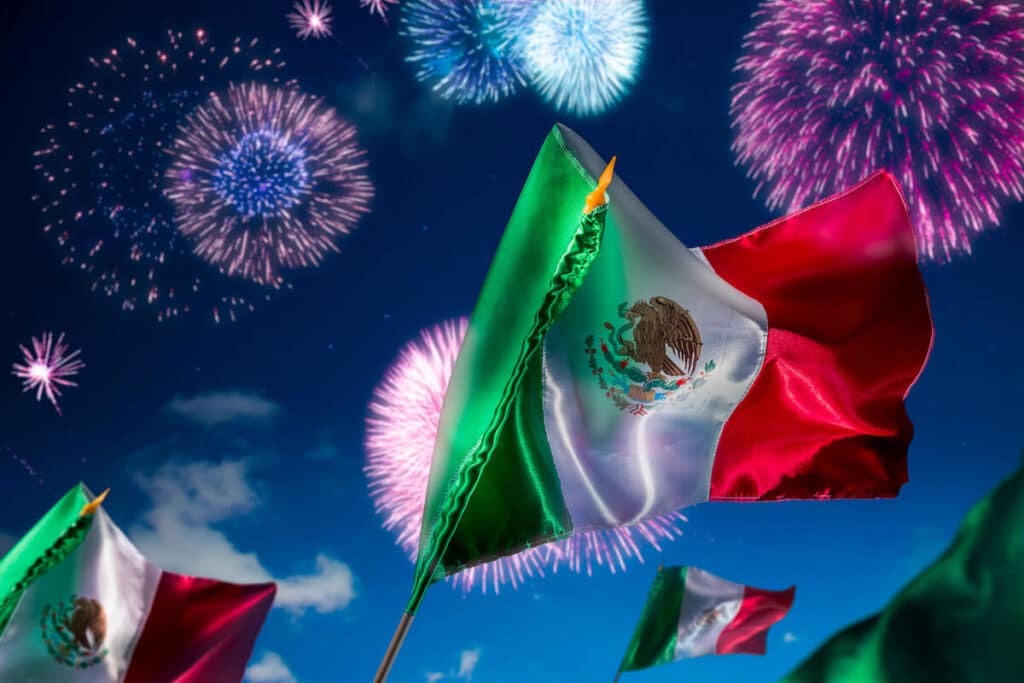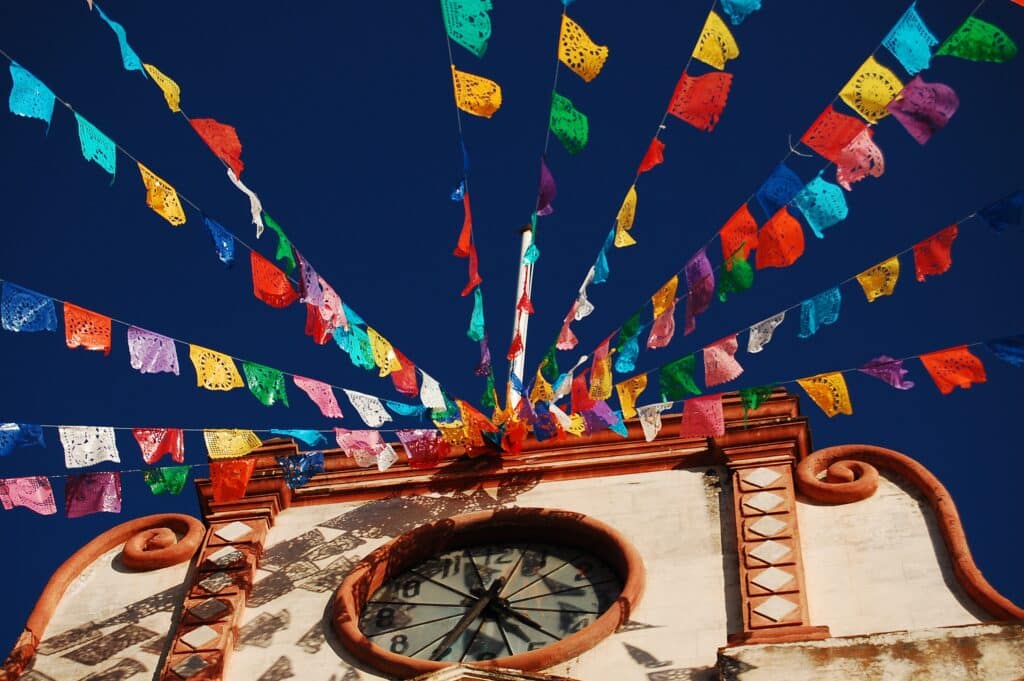Last updated on March 7th, 2024 at 02:57 pm
When people think of important holidays in Mexico, Cinco de Mayo and the Day of the Dead may be the occasions that first come to mind. Although perhaps not as widely known outside of Mexicans living in Mexico and abroad, Mexican Independence Day is another key annual event.
To dig deeper into the historical and cultural context of Mexican Independence Day and find out what celebrations look like inside Mexico and out, continue reading this guide created by our team here at Remitly.
When is Mexican Independence Day?

Mexican Independence Day falls on September 16. It marks the day in 1810 when a Roman Catholic priest named Miguel Hidalgo y Costilla, also known as Father Hidalgo, rallied his townspeople to fight for Mexico’s independence from Spain. That declaration marked the turning point in the struggle for the country’s independence and freedom from Spanish rule.
Mexican Independence Day (known in Spanish as Día de la Independencia, Fiestas Patrias, or simply 16 de septiembre) begins on September 15, just before midnight. It’s marked by fireworks, musical performances, and raucous cheering.
A brief history of Mexican Independence Day
Before we get into the widely celebrated Independence Day holiday details, let’s look at Mexico’s history. After all, the story of Mexico’s fight for independence from Spain is what makes the national holiday so important to the Mexican people.
How Mexico became an independent country
Spain has a long history of colonization that differs from its current reputation as an easy-going Western European nation. The Spanish conquest of the Aztecs, Incan, and other indigenous people of Mexico began around 1519, when Spanish galleons, commanded by Hernán Cortés, landed on the island of San Juan de Ulúa in search of wealth.
Less than two years after their arrival, the Spaniards took the city of Tenochtitlán from the Aztecs, which at the time was one of the most developed cities in the Western hemisphere.
Cortés used local alliances to gain the upper hand in the region and slaughter hundreds of Aztec nobles. This included the death of Tenochtitlán’s ruler, Moctezuma.
By 1574, Spain had enslaved most of the Aztec empire, and over 20 million more people would die from Old World diseases the Spanish brought to the New World.
Spanish rule over New Spain, the land that would become known as Mexico, removed power from local peoples. Spain took full economic control, from creating the currency to profiting from all natural resources, and Mexicans became second-class citizens. Roman Catholicism also took a firm hold in the region.
Nearly 300 years after Cortés’ conquest, Father Hidalgo had become one of Mexico’s leaders fighting for independence from colonial rule. It’s believed he made the cry for independence, known as el Grito de la Independencia, or el Grito de Dolores, in the town of Dolores, in the present-day state of Hidalgo.
The word “Dolores” in Spanish means “sorrows,” so “the cry of Dolores” can also be read as an expression of the deep pain of the Mexican people at the hands of Spain. In honor of his famous battle cry, the town was later renamed Dolores Hidalgo.
This call to action by Father Hidalgo and his fellow revolutionaries helped mobilize the people of Mexico to rise against the Spanish crown.
Hidalgo himself was executed just eleven days after launching the struggle, but his followers persisted. Juan Aldama, José María Morelos, and Ignacio Allende were among the revolutionaries who led the cause.
A decade later, in 1821, Mexico won its independence.

The establishment of Mexican Independence Day as a holiday
After the fight for independence proved successful, the war-torn country didn’t begin to celebrate the victory as a holiday immediately. Soon after, Agustín de Iturbide became the emperor of Spain, and he served in this role until 1823. During his reign, people remembered the War of Independence on September 27, when the country officially declared its independent status.
After Iturbide was removed from power, there was a push to hold a grand celebration like the Fourth of July in the USA. At that time, there were celebrations on both September 16 and 27.
While General Porfirio Díaz served as President of Mexico, September 15 and 16 became the more popular days to celebrate because the holiday coincided with his birthday.
In 1910, President Díaz unveiled the Angel of Independence statue in Mexico City to pay tribute to Father Hidalgo as a part of the festivities. During the event, he gave a moving speech and rang the same bell Hidalgo had rung in the town of Dolores a century before.
From that point forward, September 16 was the official date for Independence Day.
How do people celebrate Mexican Independence Day?
Celebration in Mexico City
On the evening of September 15, Mexico City holds a large Independence Day celebration on the zócalo, its central plaza outside the National Palace. Fireworks and musical performances last late into the night.
Around 11:00 p.m., the Mexican president and their family go onto the presidential balcony to recite an updated version of the Grito. In lieu of a speech, the family recreates the original cry of Hidalgo for the assembled crowd.
Next, the expanded version of the “grito” encompasses more recent Mexican history, honoring illustrious citizens of post-independence Mexico who have made significant contributions to the country. The presidential family ends the Grito with the traditional shouts of “Viva México!” or “Long live Mexico!”
How Mexican families observe Independence Day
Many families and friends gather starting on the evening of September 15th to kick off the holiday that will begin at midnight. The colors of the Mexican flag — green, white, and red — are all around at Mexican Independence Day celebrations.
As with any other important holiday, friends and family enjoy delicious traditional foods and drinks. You can also hear celebratory cries of “Viva Mexico” or “Viva la independencia nacional” and possibly the sound of a church bell ringing in the town.
Mexican flags hang throughout public and private spaces, and many people may choose to dress in traditional clothing. Men wear serapes, sombreros, and light, boxy shirts known as guayaberos. Women often wear huipil, quechquémitl, and a variety of traditional skirts.
Musicians often play traditional music referencing and inspired by the Grito de Dolores.
Independence Day food and drink
These gatherings focus on celebrating all aspects of Mexican culture passed down through the centuries. Celebrants prepare and serve a variety of foods, including:
- Pozole: A beef stew often made with poblano chiles, onion, garlic, radishes, and avocado
- Pancita: A soup made of tripe and a red chili pepper broth
- Enchiladas: Corn tortillas stuffed with meats, cheeses, beans, and other fillings
- Queso fundido: Hot melted cheese and chorizo
Mexican alcoholic beverages are also popular. Surveys showed that tequila is the drink of choice for 72% of Mexico Independence Day celebrations. As you may not be aware, Mexico has a long-established history of winemaking, and those wines are also a popular choice for Mexican Independence Day celebrations.
September 16th celebrations in the United States

With over 37 million residents of Mexican origin, the U.S. is the largest country outside of Mexico to celebrate Mexican Independence Day.
You can find large celebrations throughout the country in major urban areas like Seattle, Minneapolis, Los Angeles, Las Vegas, and more. They often include parades, musical performances, and a version of Mexico’s Grito de Dolores recited by an important local community member.
Of course, no Fiestas Patrias celebration is complete without traditional food and drink, no matter where it’s held.
In the USA, Mexican Independence Day marks the start of National Hispanic Heritage Month, a time when America recognizes the contributions that Hispanic immigrants have made.
How is Cinco de Mayo different from Mexican Independence Day?
In the USA, Independence Day is often confused with Cinco de Mayo. Although both holidays commemorate important events in Mexico’s history, they differ.
Observed on May 5, Cinco de Mayo commemorates when Mexican forces defeated French troops at the Battle of Puebla during the Franco-Mexican War. This happened in the relatively new nation in 1862, well after Mexico’s independence from Spain.
As previously explained, Independence Day is a time of expressing national pride and remembering the struggle for independence from Spanish rule, not the Battle of Puebla.
Celebrating Mexican Independence Day wherever you are
September 16 holds deep historical and cultural meaning for the Mexican people. We hope you get a chance to celebrate this day wherever you are in the world. It’s a chance to enjoy parades, music, and tasty treats and to honor Mexican history with joy and reverence.
September 16th is also an important day for Mexican immigrants to stay connected to their families and culture, regardless of where they live.
In recognition of Mexico’s Independence Day, send a gift to your loved ones in Mexico. From villages to major cities, gas stations to banks, you can send cash or bank deposits to thousands of locations across the country.
